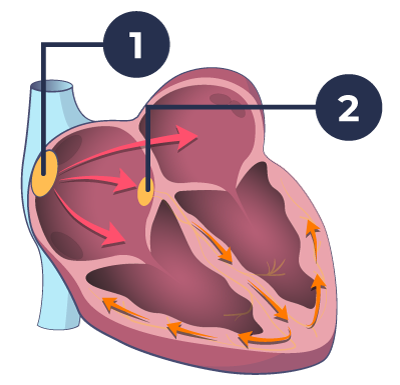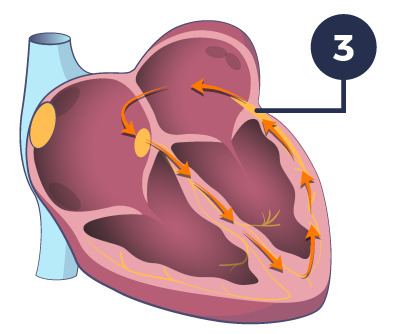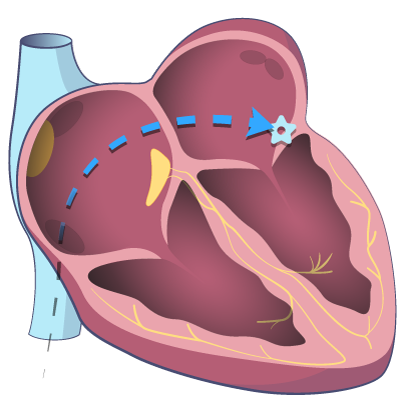WPW syndrome is named after three doctors: Wolf, Parkinson and White, who in 1930 described this condition. Patients with WPW have an extra lead path between the atria and heart chambers, known as ventricles. It most often occurs between the left atrium and the left ventricle. The condition is caused by the fact that the annulus of the heart valve between the atrium and ventricle is not able to completely close. This in turn creates an extra pathway where electrical impulses can pass from the atria to the heart chamber or visa versa.

Normal propagation of the electrical impulses
- Sinus node
- AV-node

Carousel propagation of cardiac impulses in WPW syndrome (“Extra pathway”)
3. Extra pathway
Problems typically associated with WPW syndrome
This condition is congenital, and on its own is no cause for concern. However, there are two problems that are typically associated with WPW syndrome:
The first is that the extra pathway can give rise to an arrhythmia of the carousel variety, in which the electrical impulses run backwards through the extra conduit from the ventricle to the atrium. From here, these impulses can flow back through the AV node, which causes the heart rate to suddenly increase to 170-200 beats per minute. This fast rhythm can last for a few minutes, sometimes longer, before suddenly stopping. This type of arrhythmia can be bothersome, but is typically harmless in isolation.
The second problem arises in patients who have another common heart rhythm disorder, called atrial fibrillation. In this case, there is a risk that the very fast flicker pulses may transfer uninhibited to the heart chambers. In that case, you get a very fast and irregular pulse, which can be extremely unpleasant – but can also develop into fibrillation of the heart chambers (ventricular fibrillation), which is a life-threatening heart rhythm disorder.
How is WPW-syndrome treated?
Patients can be treated for WPW with medication, typically either beta-blockers or calcium-blockers. In rare cases, patients have been prescribed Tambocor (flecainide). For many patients, an ablation treatment will be recommended and is normally recognized as the treatment of choice and is curative.
Ablation treatments involve burning the heart tissue in order to prevent the passage of electrical impulses. The treatment is very simple and will be curative in over 95% of cases, with very low risk of complications.

Ablation of an “extra pathway” in WPW; Ablation catheter
The ablation treatment is performed from the groin, where local anesthesia is given. In addition, doctors will often give some relaxing and analgesic medication directly into the bloodstream. A patient will typically be discharged the same day or the day after and should expect to be on sick leave for a few days. Sports activities or other more demanding physical activities can be resumed after a week.